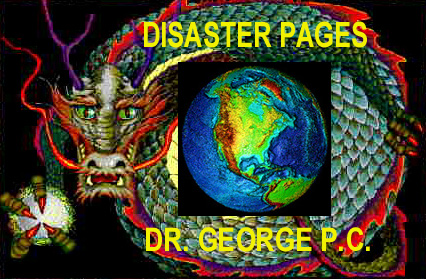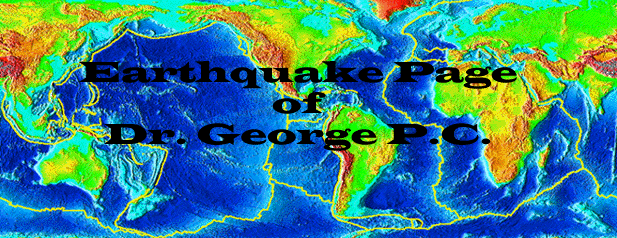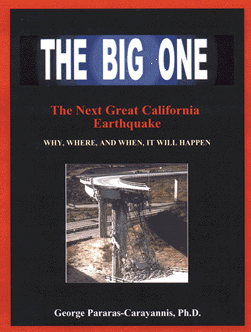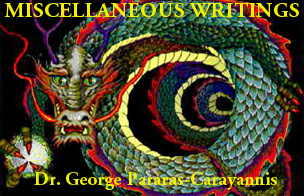|
The
Earthquake and Tsunami of 26 May 1983 in the Sea of Japan / East
Sea
George
Pararas-Carayannis
Copyright © 2000. All Rights
Reserved

INTRODUCTION
 On 26 May, 1983, a major earthquake
- named the "Nihonkai-chubu (Japan sea ) Earthquake of 1983
- occurred in the Central Sea of Japan (Japan Sea). The earthquake
generated a major local tsunami which was destructive in Japan
and Korea. Almost all of the destruction and deaths near the
northern coast of Akita and elsewhere in Japan and Korea were
caused by the tsunami. On 26 May, 1983, a major earthquake
- named the "Nihonkai-chubu (Japan sea ) Earthquake of 1983
- occurred in the Central Sea of Japan (Japan Sea). The earthquake
generated a major local tsunami which was destructive in Japan
and Korea. Almost all of the destruction and deaths near the
northern coast of Akita and elsewhere in Japan and Korea were
caused by the tsunami.
Date and Time of Occurrence
- 26 May 1983; 12:00
Epicenter - 40.46 N 139.10 E NEAR WEST COAST
OF HONSHU, JAPAN.
Magnitude - The
magnitude was invariably given as Ms 7.7 (BRK), 7.7 (PAS), 7.8
(PAL) and as 7.9 (Mw)
Quake Felt - The earthquake ground motions
were strongly felt throughout northern and central island of
Honshu and in Hokkaido.
Earthquake Focal Mechanism
- The focal mechanism
of this earthquake was moderately well controlled and corresponded
to reverse faulting.
Seismicity of the
Region - The seismicity
of Northern Japan is the result of a double seismic zone (DSZ),
and compressional deep trench and outer rise events and by the
magmatic effects of plumes or superplumes which, originally,
may have hydrated the subducting oceanic lithosphere. Usually,
shallow normal faulting occurs in the trench-outer rise region.
Earthquakes in the Sea of Japan occur less frequently.
Damages and Death
Toll from Earthquake and Tsunami - The earthquake and tsunami waves caused extensive
damage to dwellings, roads, and vessels along the Japan Sea coast
from southern Hokkaido to the Niigata area, Honshu. At least
104 people were killed and 325 others were injured. 5100 houses
were damaged. Many of the casualties and much of the damage occurred
on the Oga Peninsula of the Akita Prefecture. Most of the earthquake
damage to buildings resulted from ground liquefaction. Tsunami
damage occurred as far away as the Yamaguchi Prefecture in southwestern
Honshu, along the Japan Sea coast of Russia ( then USSR), and
along the eastern and southern coasts of South Korea, where three
people were killed.
 Tectonic
Setting of the Northern Japan/Kuril Island Region
Tectonic
Setting of the Northern Japan/Kuril Island Region
 Tectonic Setting - The overall tectonics of northeast
Asia are very complicated. Whether the Sea of Okhotsk and the
northern Japanese islands are part of the North American plate
or of a separate Okhotsk plate has not been determined. On the
Pacific Ocean side, earthquake slip vectors along the Kuril and
Japan trenches are consistent with either a Pacific-North America
or a Pacific-Okhotsk plate motion. We will assume that the Pacific-North
America plate motion is better supported. Tectonic Setting - The overall tectonics of northeast
Asia are very complicated. Whether the Sea of Okhotsk and the
northern Japanese islands are part of the North American plate
or of a separate Okhotsk plate has not been determined. On the
Pacific Ocean side, earthquake slip vectors along the Kuril and
Japan trenches are consistent with either a Pacific-North America
or a Pacific-Okhotsk plate motion. We will assume that the Pacific-North
America plate motion is better supported.
The Kuril island arc
is located between the Kamchatka Peninsula and the Japanese island
of Hokkaido. The Kuril Trench has been formed by the subduction
of the Pacific plate under the North American plate. It extends
from the offshore central area of Kamchatka to Hokkaido.
The plate tectonics
of the Southern Kuril islands-Northern Hokkaido region are quite
complex and very different than those along the southern portion
of the Japanese Trench. The South Kuril Islands are part of the
Kuril arc in the Okhotsk plate which has been colliding westward
against the Northeast Japan arc, along the Hidaka Collision Zone
(HCZ), where new continental crust is created by active arc-arc
collision.
Deep seismic reflection
studies (Ito,
Kazuka @Abe, 2001) show
the lower crust of the Kuril arc to be delaminated at a depth
of about 23 km. These studies indicate that the upper half (above
23 km) - consisting of the earth's upper crust and the upper
portion of lower crust of the Kuril arc - is thrusting over the
Northeast Japan arc along the Hidaka Main Thrust (HMT). However,
the lower half (below 23 km) - consisting of the lower portion
of lower crust and upper mantle material - is descending downward.
 Ocean bottom morphology of Kamchatka,
the Kuril Island Trench, Sakhalin Island, and the Sea of Okhotsk. Ocean bottom morphology of Kamchatka,
the Kuril Island Trench, Sakhalin Island, and the Sea of Okhotsk.
As a result of such
kinematic processes, the wedge of the Northeast Japan arc is
intruded into the delaminated Kuril arc, as the Pacific plate
is subducting northward beneath both of the above mentioned structures,
thus continuing the arc-arc collision (and continental crust
production). The complex, seismo- tectonic kinematic process
of this region has been named "Delamination-wedge-subduction
system" - which may apply also to other areas where active
arc-arc collision and concurrent subduction take place.
Accordingly Hokkaido
- Japan's northernmost island - extends northeast into Kuril
Islands and is composed of multiple compressed island arcs. The
northern half of Honshu (north of Tokyo), which is Japan's main
island, represents a typical mature island arc, with the Pacific
plate subducting below the North American plate, while the southern
half of the island represents also a typical mature island arc,
as the Philippine Sea plate subducts below the Eurasian plate.
On the western side,
the Sea of Japan is a complex basin between Japan and the Korea/Okhotsk
Sea Basin. It represents another subplate with apparent rotational
movement as it interacts against the Okhotsk plate, along the
inland sea boundary of the Hidaka Collision Zone (HCZ). Sakhalin
island , north of Hokkaido, which separates the Sea of Japan
from the Sea of Okhotsk, is probably the result of transpressional
tectonics along the North America-Eurasia boundary. The 1983
earthquake and tsunami in the Sea of Japan occured south of the
boundary of these interacting subplates. This a seismic region
that has generated tsunamis in the past, which have caused considerable
damage along the Japanese, Russian and Korean coasts.
The
Tsunami of 26 May 1983 in the Sea of Japan / East Sea
 The Tsunami The Tsunami
The earthquake of
26 May 1983 generated a destructive tsunami in the Sea of Japan.
The first of the destructive tsunami waves took seven minutes
after the earthquake to strike the coast of the Akita Prefecture
in the north-east part of the Honshu Island, in northern Japan.
Maximum waves reached 14 m along the coast of Akita. Also, the
eastern coast of Korea was struck by destructive waves.
 There was no sufficient time
to issue a local warning. A warning was issued about 13- 15 minutes
after the earthquake. It was too late. One hundred four persons
died in Japan and three more in Korea. There was extensive destruction
of houses, ships and port facilities. There was no sufficient time
to issue a local warning. A warning was issued about 13- 15 minutes
after the earthquake. It was too late. One hundred four persons
died in Japan and three more in Korea. There was extensive destruction
of houses, ships and port facilities.
Tsunami Generating
Area and Tsunami Travel Times in the Sea of Japan and around
the Japanese Islands ( in minutes) .
Subsequent surveys
of the affected region along the western coast of Japan , sponsored
by Japan's National Research Center for Disaster Prevention,
documented the effects and runup heights of the tsunami waves.
The results of these surveys are summarized here.
Tsunami Wave Heights
- Estimated tsunami
heights were 14 meters at Minehama, Honshu, 2-6 meters along
southern Hokkaido and northern Honshu, up to 8 meters along the
coast of Russia (USSR at the time), and ranged between 2-7.5
meters along the coast of South Korea.
Damages and Death
Toll from the Tsunami -
Many  of the casualties
and much of the tsunami damage occurred on the Oga Peninsula
of the Akita Prefecture. Tsunami damage occurred as far away
as the Yamaguchi Prefecture in southwestern Honshu, along the
Japan Sea coast of Russia ( then USSR), and along the eastern
and southern coasts of South Korea, where three people were killed. of the casualties
and much of the tsunami damage occurred on the Oga Peninsula
of the Akita Prefecture. Tsunami damage occurred as far away
as the Yamaguchi Prefecture in southwestern Honshu, along the
Japan Sea coast of Russia ( then USSR), and along the eastern
and southern coasts of South Korea, where three people were killed.
The tsunami comletely
destroyed Oga Peninsula in Japan
The Tsunami in the
Akita Prefecture of Japan - The
tsunami reached more than 11 m (max 14 m.) along the Akita Prefecture
in the northern coast of Japan.There was extensive destruction
of houses,buildins, ships and port facilities. It caused a number
of fatalities. A total of 104 persons died. The tsunami destroyed
700 boats and 59 houses for a total of $800 million in property
damage (1983 dollars).

The Effects of the
Tsunami in Southern Korea -
It took approximately 90 minutes for the first tsunami wave to
travel across the Japan Sea and strike the east coast of the
Korean Peninsula. This was the first tsunami to inflict heavy
damage on the eastern coast of Korea since the 1741 Oshima-oshima
tsunami. According to observations, the wave reached a height
of 5 meters on Ullung Is.. Samchuk port, Geunduk, Yongwha beach
and Yongwha port were also affected. Damage was particularly
significant at the Imwon port, where tsunami runup height was
about 3.6 m. On a coastal road close to Imwon the tsunami runup
reached 5.1 m. Maximum runup of 7.5 m occurred at the upper part
of the town along the river. Three persons were killed and twenty
houses were damaged or destroyed.
At Wondok Town and
Kangwon-do, a maximum tsunami height of 3.6-4.0m was recorded.
Fishing boats were carried into the residential area, and a gas
oil tank holding 130,000 litters was carried by about 10 meter.
One person was killed at Tonghae City. The amount of damage in
the Republic of Korea was estimated to be about 400 million won
(about $500,000 - 1983 US dollars).
Tide gauge recordings in South Korea showed the initial sea level
movement to be rise at Pusan. Ulsan, Mukho (Tonghae City), Sokch'o,
and Chodong (Ullung Island). However, at P'ohang port the tide
gauge record indicates an initial drop in sea level.

 Lessons Learned - Even in a country like Japan
where there is considerable awareness of the tsunami danger,
it is very difficult to issue local warnings when the earthquake
source is so close to the coast. However, as a result of this
tsunami, there was an increased effort for public education.
Japan introduced a new regional system which offers a shorter
lead time for tsunami warnings. Lessons Learned - Even in a country like Japan
where there is considerable awareness of the tsunami danger,
it is very difficult to issue local warnings when the earthquake
source is so close to the coast. However, as a result of this
tsunami, there was an increased effort for public education.
Japan introduced a new regional system which offers a shorter
lead time for tsunami warnings.
Historical
Tsunamis in the Sea of Japan / East Sea
Historical tsunamis
generated by earthquakes along the possible boundary of the Eurasian
and the North American plates, in the Sea of Japan, have been
responsible for a great deal of destruction along the coastal
areas of Japan, Russia and Korea. A review of archival material
in Japan and Korea will undboubtedly reveal the occurrence of
many historical tsunamis in the Sea of Japan - perhaps as many
as 6-8 events spaced apart in time and location. Most noteworthy
of the known historical events are the following.
Recent reports in
the literature, quoting records of the Choson Dynasty, indicate
that the Kampo earthquake of 1741 (estimated magnitude M = 7.5),
off the southwestern coast of Hokkaido, in the Sea of Japan,
generated a destructive tsunami that was responsible for the
death of about 1,500 people and that the waves affected the entire
coast of Kangwondo, destroying houses and boats.
More recently, the earthquake of 1949 (M = 7.5) - known as the
Kamuizaki-Oki Earthquake - and the Tsunami it generated were
destructive. In the east coast of the Korean Peninsula, the tsunami
waves ranged up to 2.0m at Uljin, Kyongsang-Pukdo, and the island
of Ullung.
 Photos
of tsunami effects, inundation and destruction along the Akita
Prefecture of Japan
Note the
movement of the heavy, concrete tetrapods which had been placed
for protection along the shore
Photos
of tsunami effects, inundation and destruction along the Akita
Prefecture of Japan
Note the
movement of the heavy, concrete tetrapods which had been placed
for protection along the shore


 REFERENCES
AND FURTHER READING
(Tetsuzo
Seno and many other Japanese and Korean scientists have studied
extensively the tectonic interactions along the Japanese arc.
The following are selected references for further reading on
the kinematics of this complex tectonic area of the world, which
historically has produced numerous destructive tsunamis).
REFERENCES
AND FURTHER READING
(Tetsuzo
Seno and many other Japanese and Korean scientists have studied
extensively the tectonic interactions along the Japanese arc.
The following are selected references for further reading on
the kinematics of this complex tectonic area of the world, which
historically has produced numerous destructive tsunamis).
Aida, I. (1984), A source models of the 1983
Nihonkai-earthquake tsunami,
Proceeding of 3rd UJNR(UnitedStates-Japan Cooperative Program
in Natural Resources) Tsunami Workshop, pp. 57-76.
Nakamura, K., V. Renard,
J. Angelier, J. Azema, J. Bourgois, C. Deplus, K. Fujioka, Y.
Hamano, P. Huchon, H. Kinoshita, P. Labaume, Y. Ogawa, T. Seno,
A. Takeuchi, M. Tanahashi, A. Uchiyama, and J. L. Vigneresse.
Oblique and near
collision subduction, Sagami and Suruga troughs -Preliminary results of French-Japanese 1984
KAIKO cruise, leg 2 Earth Planet. Sci. Lett. 83 229-242 1987
Nakasa, Y., and T. Seno. Compensation
mechanism of the Yamato Basin, Japan Sea J. Phys. Earth 42 187-195 1994
NIDP (1999), Study
on tsunami hazards mitigations along the Korean eastern coast(I),
Report of NIDP (National
Institute for Disaster Prevention), 192 pp.
Ogawa, Y., T. Seno, H. Akiyoshi, H. Tokuyama, K. Fujioka, and
H. Taniguchi. Structure
and development of the Sagami Trough and off-Boso triple junction Tectonophysics 160 135-150,
1989
Kawakatsu, H., and T. Seno. Triple
seismic zone and the regional variation of seismicity along the
northern Honshu arc.
J. Geophys. Res. 88 4215-4230 1983
Renard, V., Nakamura, K., J. Angelier, J. Azema, J. Bourgois,
C. Deplus, K. Fujioka, Y. Hamano, P. Huchon, H. Kinoshita, P.
Labaume, Y. Ogawa, T. Seno, A. Takeuchi, M. Tanahashi, A. Uchiyama,
and J. L. Vigneresse. Trench
triple junction off central Japan - Preliminary results of French-Japanese 1984
KAIKO cruise, leg 2 Earth Planet. Sci. Letters 87 243-256 1987
Seno, T. and D. G.
Gonzalez. Faulting
caused by earthquakes beneath the outer slope of the Japan Trench. J. Phys. Earth 35 381-407 1987
Seno, T. Is northern
Honshu a microplate?
Tectonophysics 115 177-196 1985
Seno, T. Syntheses
of the regional stress fields of the Japanese islands The Island
Arc 8 66-79 1999
Seno, T., and Y. Yamanaka. Arc
stresses determined by slabs: Implications for mechanisms of
back-arc spreading
Geopys. Res. Lett. 25 3227-3230 1998
Seno, T., and Y. Yamanaka. Double
seismic zones, compressional deep trench - outer rise events
and superplumes in Subduction Top to Bottom, edited by G. E. Bebout, D. W. Scholl, S. H.
Kirby, and J. P. Platt Geophys. Monogr. 96 347-355 1996
Seno, T., T. Sakurai, and S. Stein. Can the Okhotsk plate be discriminated from the
North American plate? J.
Geophys. Res. 101 11305-11315 1996
Seno, T. Intraplate
sesmicity in Tohoku and Hokkaido and large interplate earthquakes:
A possibility of a large interplate earthquake off the southern
Sanriku coast, northern Japan
J. Phys. Earth 27 21-51 1979
Seno, T. Pattern of intraplate seismicity
in southwest Japan before and after great interplate earthquakes Tectonophysics 57 267-283 1979
Seno, T., Shimazaki,
K., Somerville, P., Sudo, K., and T. Eguchi. Rupture process of the Miyagi-Oki, Japan, earthquake
of June 12, 1978
Phys. Earth Planet. Inter. 23 39-61, 1980
Seno, T., and B. Pongsawat.
A triple-planed structure
of seismicity and earthquake mechanisms at the subduction zone
off Miyagi Prefecture, northern Honshu, Japan Earth Planet. Sci. Lett. 55 25-36, 1981
Seno, T., and G. C.
Kroeger. A reexamination
of earthquakes previously thought to have occurred within the
slab between the trench axis and double seismic zone, northern
Honshu J. Phys. Earth
31 195-216 1983
Seno, T., and T. Takano. Seismotectonics
at the trench-trench-trench triple junction off central Honshu Pure Appl. Geophys. 129 27-40,
1989
Seno, T., T. Sakurai,
and S. Stein. Can
the Okhotsk plate be discriminated from the North American plate? J. Geophys. Res. 101 11305-11315,
1996
Seno, T., and Y. Yamanaka.
Double seismic zones,
compressional deep trench - outer rise events and superplumes
in Subduction Top to Bottom,
edited by G. E. Bebout, D. W. Scholl, S. H. Kirby, and J. P.
Platt Geophys. Monogr. 96 347-355, 1996
Seno, T. Earthquake
Research Institute, University of Tokyo, Bunkyo-ku, Tokyo 113-0032,
Japan The Island
Arc, 8, 66-79, 1999
Watanabe, T., T. Koyaguchi, and T. Seno. Tectonics stress controls on ascent and emplacement
of magmas J. Volcanol.
Geotherm. Res. 91 65-78, 1999
 Return to
Return to

  Links to other
Pages
Links to other
Pages

 Now available
from Amazon, Barnes and Noble and other major bookstores. A signed
by the author copy can be also ordered by contacting directly
by email Aston
Forbes Press.
Now available
from Amazon, Barnes and Noble and other major bookstores. A signed
by the author copy can be also ordered by contacting directly
by email Aston
Forbes Press.
 Other
Miscellaneous Non-technical Writings
Other
Miscellaneous Non-technical Writings
 (©) Copyright
1963-2007 George Pararas-Carayannis / all rights reserved / Information
on this site is for viewing and personal information only - protected
by copyright. Any unauthorized use or reproduction of material
from this site without written permission is prohibited.
(©) Copyright
1963-2007 George Pararas-Carayannis / all rights reserved / Information
on this site is for viewing and personal information only - protected
by copyright. Any unauthorized use or reproduction of material
from this site without written permission is prohibited.
|